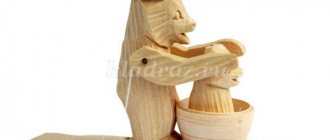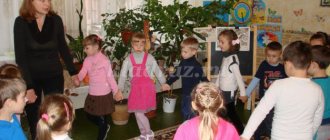Senior group. Senior preschool age. Children 5-6 years old
Thematic lesson on speech development senior group for the anniversary of the birth of A. N. Nekrasov “Grandfather Mazai and the Hares” Purpose: to introduce children to the work of N. A. Nekrasov and his works. Objectives: to develop in children a poetic taste and imaginative thinking, the ability to respond emotionally to an event described by the author. To instill a caring attitude towards nature and animals. Equipment: presentation…
Summary of a lesson on speech development in the senior preparatory group “Aquarium fish” Summary of a lesson on speech development , lexical topic aquarium fish. Mixed group (senior and preparatory, teacher Antonova T.V. November 2021. Goals: Educational: Expanding ideas about fish, their appearance, lifestyle and habits. Clarification,…
Notes on the development of coherent speech in the middle group
municipal budget preschool institution
"Kindergarten No. 15 "Romashka"
General developmental type with priority implementation of activities in the physical direction of children's development
Summary of educational activities for speech development in the middle group Topic: “Storytelling based on the painting “Dog with Puppies”
| Compiled; Teacher of the 1st category: Baikina R.Sh. |
Sharypovo - 2022
Target:
Strengthen children's ability to describe a picture in a certain sequence and name the picture.
Tasks:
“Speech development”:
Teach children to describe a picture, making up a small, coherent story following the example of the teacher. Continue teaching children to answer the teacher’s questions. Help children coordinate words in sentences. Improve the ability to correctly use prepositions in speech. Continue learning to form the plural form of nouns denoting baby animals. Learn to use the most common adjectives, verbs, adverbs, and prepositions in speech. Learn to listen to other children's answers.
"Cognitive development":
Develop memory, attention, thinking.
“Social and communicative development”:
Foster a caring attitude towards animals and friendly relationships between peers.
Materials and equipment:
toy – dog, leaves on strings for breathing exercises, painting “Dog with puppies” (series “Pets” by S. A. Veretennikova), easel, Lego set.
Musical accompaniment:
song “Man is a Dog’s Friend” (lyrics by M. Libin, music by V. Komarov)
OD progress
In the morning, before OD, the teacher brings the painting “Dog with Puppies” to the group, places it on the easel and leaves it for the children to examine on their own. When looking at the picture, children exchange impressions and manage to notice many details. At the request of the teacher, the children come up with a name for the picture.
1. Organizational moment.
Children with a teacher are sitting on the carpet.
Educator: Guys, you have already noticed that such a picture appeared in our group today. (The teacher draws the children’s attention to the easel where the painting is located.) Guess the riddle and find out who brought it to us.
The teacher asks a riddle:
He is friends with the owner,
The house is guarded
Lives under the porch
Tail in a ring.
(Children's answers.)
The teacher brings a puppy toy into the group. The children greet him. They pet him.
Educator: This puppy came running to visit us today and brought a painting with him. He was so sad. I asked what happened. He answered me that this picture hangs in his house, in his booth, he likes it so much, but he cannot tell his friends what is depicted in it, because he does not know how to tell a story from the picture. That's why he came running to us for help. Guys, can we help the puppy? (Children's answers.) In order for our story to be correct and understandable, we will do breathing exercises.
Learning to Write Narrative Stories
The preschooler acquires the skills of coherent speech, learns to talk about one topic, and learns the signs of different subjects. It also helps him expand his vocabulary.
To enrich vocabulary, you need to teach children to prepare for writing descriptive stories, remind them what signs the described objects may have. First, the child learns to describe a single object. Then he learns to compare similar objects based on characteristics. He compares trees, fruits, animals - everything that is close to his thinking.
Abstract of OOD on the development of coherent speech in the senior group Topic: “Household Appliances”
Abstract of OOD on the development of coherent speech in the senior group
Topic: "Household Appliances"
Program objectives: correctional and educational:
Strengthen children's knowledge about household appliances and their purpose; about the color, size, shape and benefits of individual modern household appliances;
Activate children's vocabulary on the topic "Household Appliances", improve grammatical structure (practical use of prepositions, word formation), teach children to compose a story according to a diagram, develop children's coherent speech;
correctional and developmental:
develop attention, memory, thinking, coordination of speech and movement;
correctional and educational:
develop the ability to carefully handle household appliances.
Equipment:
object pictures depicting household appliances, a panel “Apartment”, a doll, symbols of prepositions, plot pictures, diagrams for making sentences.
Move
1. Organizational moment.
So guys, let's start the lesson with kind words
. Look at each other, smile and say good morning.
2.Introduction to the topic
.
Q: Guys, do you remember the fairy tale “Cinderella”? /Puts a picture of Cinderella on the easel. /The poor girl was very tired because she did all the housework herself.
D: She washed the dishes, heated the stove with wood, swept the floor, and washed the clothes.
Q: Let's remember what assistant objects helped her in her work? (Cast iron, broom, rag, bucket, + other off-topic items.) The teacher puts the necessary pictures on the easel, names the objects and what kind of work they do.
Q: What do you think could make Cinderella’s job easier?
Children: Cinderella could use household appliances.
Q: What are home appliances?
D: Household appliances are devices, devices that help a person in life, in everyday life. It was created to make our lives easier.
3. Exercise “What are household appliances for?”
What is an iron for? (kettle, refrigerator, TV, vacuum cleaner, etc.)
4. Game “Wizard” (writing short descriptive stories).
Q: Household appliances provide great help to people, but Cinderella does not have household appliances. Let's help Cinderella learn as much as possible about household appliances?
Speech therapist: Cinderella, we decided to help you to make your work easier. What is this? And we will teach you how to use it. The guys will “turn” into household appliances and talk about them, and this diagram will help them with this - a support.
5. Consideration of the device description diagram:
for example, I am a washing machine - I am large, electric, people need it in order to wash clothes. etc.).
6. Physical exercise.
No, no need to hunch your back
Over the trough day after day - After all, the washing machine will handle the laundry in an instant.
Development of coherent speech
At an older age, learning tasks become more complicated: children must not only understand the content of the picture, but also coherently and consistently describe all the characters, their relationships, and the setting, using a variety of linguistic means and more complex linguistic structures. The main requirement is greater independence in telling stories based on pictures.
In the older group, the following types of descriptive stories based on the picture can be distinguished:
Description of the objects depicted in the picture and their semantic relationships.
Description of the painting as a disclosure of a given topic.
A detailed description of a specific object.
Verbal and expressive description of what is depicted using analogies
(poetic images, metaphors, comparisons, etc.)
In the preparatory group, all types of paintings and all types of children's stories are used. Particular attention is paid to independence and creativity. Works of fiction are often used as speech samples: short stories by L.N. Tolstoy, K.D. Ushinsky, E. Charushin, V. Bianki.
Classes are conducted on multi-episode films.
The picture is examined in parts, creative tasks are used, children are encouraged to ask questions themselves, the vocabulary is activated and enriched with figurative expressions. The teacher can start a story about one of the episodes, the children continue, collective storytelling is used.
A special type of coherent storytelling are description stories based on a landscape painting.
This type of story is especially difficult for children.
Elements of a story plan based on a landscape painting can be silhouetted images of its objects, both clearly present in the painting and those that can only be identified by indirect signs. A visual model of an utterance acts as a plan that ensures coherence and consistency in children’s stories. Objects of nature can serve as elements of the story model. Since they are usually static in nature. Particular attention is paid to describing the qualities of these objects. Work on such paintings is built in several stages:
Identification of significant objects in the painting.
Examination of them and a detailed description of the appearance and properties of each object.
Determining the relationship between individual objects in the picture.
Combining mini-stories into a single plot.
As a preparatory exercise when developing the skill of composing a story based on a landscape painting, we can recommend the “Bring the Picture to Life” technique. This work is like a transitional stage from composing a story based on a plot picture to telling a story based on a landscape painting. Children are offered a picture and small images of living “animating” objects that could appear in this composition. Children describe landscape objects, and the colorfulness and dynamism of the stories is achieved by including descriptions and actions of living objects.



